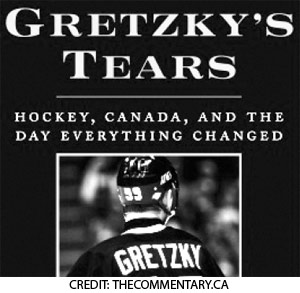Gretzky's Tears takes a look at the man behind the icon

As a Canadian national icon, no one quite compares to Wayne Gretzky. He's the epitome of the ultimate success of a stereotypical working Canadian family, a hockey prodigy who grew up to be the greatest player of our country's most popular sport. But who is the man behind the icon? Is Wayne Gretzky the person the same as Wayne Gretzky the image, or is the brand different from the man?
These are the questions that Stephen Brunt tries to answer in his book Gretzky's Tears: Hockey, Canada, and the Day Everything Changed. Brunt, a sportswriter from Toronto, focuses his book on the Gretzky trade to Los Angeles on August 9, 1988. The book's narrative leads up to and away from the trade and all of the behind-the-scenes machinations of the various parties involved, from Gretzky himself to Peter Pocklington to Bruce McNall, among others.
Brunt positions the Gretzky trade as something of an end of an era not just for the NHL, but also for the country of Canada. The book acts as a deconstruction of Gretzky's public image, analyzing the difference between Gretzky's brand name and Gretzky's personal life. Brunt makes it clear how aware Gretzky is of his brand and how controlling Gretzky is of his marketing and public image. Part of the book's focus is what Gretzky's image as a national icon actually means to Canada and how much of it is savvy marketing on the part of Gretzky and the various businessmen that have hovered around him throughout his career.
The other aspect of the book is a focus on the change in the NHL brought about by the trade. Gretzky going to L.A. opened up the hockey market to tons of new teams in the American south, creating lots of extra revenue in the form of expansion fees the league charged to all of these new owners. This didn't last long, though, as only so many new teams could be admitted to the league, and the popularity of hockey in the U.S. has greatly dwindled since its early '90s heyday. Brunt explores this transition of the NHL and how the seeds of the NHL's failure in the Deep South were planted all the way back to the day Gretzky was traded to L.A., a day that should have planted the seeds of longterm success for hockey in the south.
Brunt has quite a bit of experience writing about hockey's changing times. His previous effort, Searching for Bobby Orr, explores Orr both as a national icon and as a herald of the wide changes brought to the NHL during the late '60s expansion. That book was also as much about Alan Eagleson and Orr's business relationship with him, much in the same way that Gretzky's Tears is about Gretzky's business relationships with Pocklington and McNall.
I've read both books and I enjoyed Gretzky's Tears more, mainly because I grew up watching Gretzky play. I think for Baby Boomers who were in their youth when Orr was in his prime, Searching for Bobby Orr might be the better option. They're both excellent reads, though, for fans of hockey history as both explore the realities of the public image of two Canadian icons as well as the changes these two players brought to the national sport, changes that are still felt quite deeply in the NHL today.













